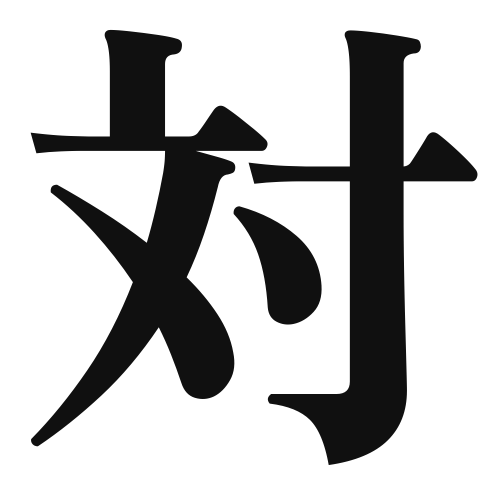1. Overview of Meaning
The kanji “対” (tai) generally means “opposite,” “against,” or “to face.” It is often used to indicate a relationship between two entities that are in contrast or opposition to each other.
2. Formation and Radical
Formation of the Kanji: The kanji “対” is a compound character, which means it is formed by combining different elements. It is classified as a 会意文字 (ideogram), where the components convey a combined meaning. The left part “対” represents the concept of facing or opposition.
Radical: The radical of “対” is “対” itself, which is used in various kanji related to opposition or comparison.
3. Examples of Usage
Common Words and Phrases: Some frequently used words that include “対” are:
- 対話 (taiwa) – dialogue
- 対策 (taisaku) – countermeasure
- 対立 (tairitsu) – confrontation
Example Sentences in Daily Conversation:
- 私たちは意見が対立しています。 (Watashitachi wa iken ga tairitsu shiteimasu.) – Our opinions are in opposition.
- この問題に対して、良い対策を考えましょう。 (Kono mondai ni taishite, yoi taisaku o kangaemashou.) – Let’s think of a good countermeasure for this problem.
4. Synonyms and Antonyms
Similar Kanji: A kanji with a similar meaning is “相” (sou), which means “mutual” or “together.” However, “相” emphasizes a relationship rather than opposition.
Antonyms: A kanji with an opposite meaning is “同” (dou), which means “same” or “together,” indicating similarity rather than contrast.
5. Cultural and Historical Background
Relation to Japanese Culture: The concept of “対” is significant in Japanese culture, especially in contexts like martial arts, where facing an opponent is crucial. It also appears in various traditional practices and philosophies.
Proverbs and Idioms: One common expression is “対岸の火事” (taigan no kaji), which means “a fire on the opposite bank,” referring to a situation that does not directly affect someone but is still concerning.
